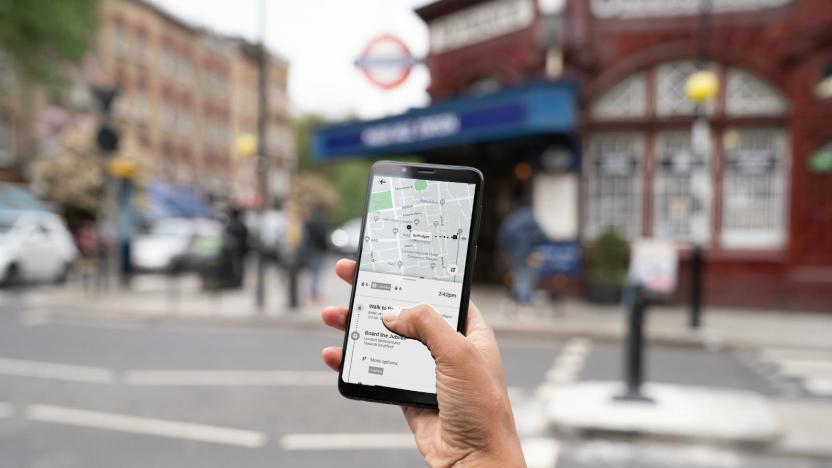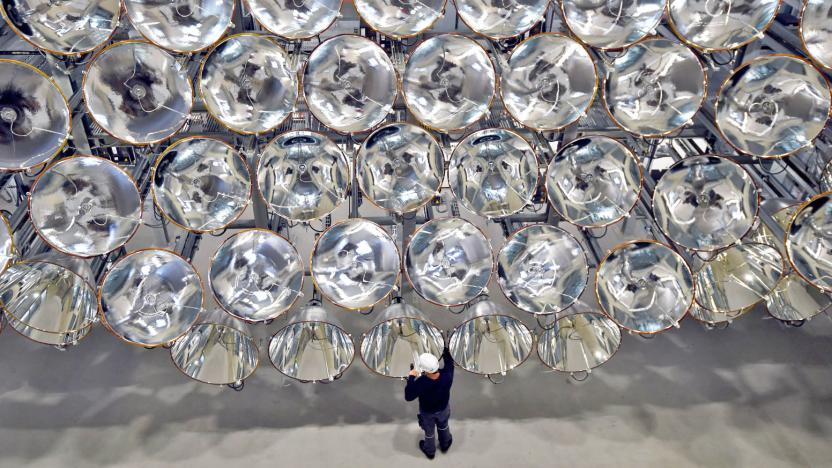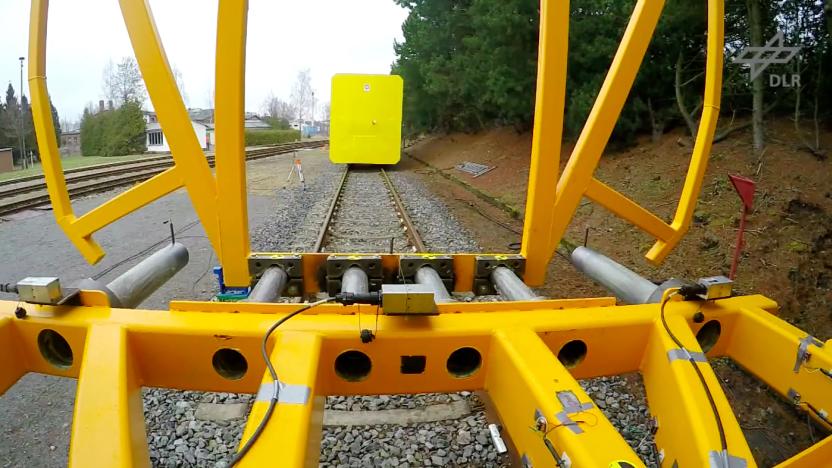DLR
Latest

Scientists describe a tiny, molten metal exoplanet in unprecedented detail
Scientists have determined that a small, super-hot exoplanet is as dense as iron — and it's the smallest alien world ever measured this way.

The ISS' spherical robot helper has returned to Earth
Humans are one step closer to having robot assistants in space. The IBM- and Airbus-made CIMON (Crew Interactive Mobile Companion) robot returned to Earth on August 27th after successful testing aboard the International Space Station. The spherical machine demonstrated both its AI skills (such as recognizing astronauts and offering instructions) as well as its ability to float through the ISS. Don't think this is the end to the experiments, though -- this is really just the start.

Uber adds London's public transportation info to its app
Londoners can now compare their public transport and ridesharing options in the Uber app. Tuesday, the company added real-time Underground, bus, train and Docklands Light Railway (DLR) info to a new "Public Transport" feature, which appears next to the UberX and UberPool options. When users search a destination, the app now generates a list of the fastest public transit routes, real-time schedules and walking directions to and from stations or bus stops.

NASA, ESA will study how artificial gravity can keep astronauts healthy
Astronauts aboard the International Space Station have to exercise and alter their diet to endure extended stays in microgravity, but NASA and the ESA hope to find a better way. They're about to start a study that will explore how artificial gravity might keep astronauts in good shape. Volunteers at the German Aerospace Center will spend 60 days in bed starting on March 25th at an incline that will send blood away from their heads. Once a day, a "selection" of the subjects will take a spin in the Center's short-arm centrifuge in a bid to send blood back toward their legs.

German researchers built a molecule-splitting artificial sun
Scientists from the German Aerospace Center (DLR) are testing a novel way to generate hydrogen, a potential green energy source, by using a massive array of lights normally found in movie theaters.

Germany's aerospace agency built a safer rail car
An aerospace agency might seem like an unlikely place to find a breakthrough in railroad safety equipment, but that is exactly what the engineers at the German Aerospace Center (better known as DLR) have recently come up with. As Wired reports, DLR engineers have designed a new less smash-prone crumple zone meant to reduce the impact of train car collisions.

Philae mission team says goodbye to the comet lander
The mostly quiet Philae comet lander appears to be silent for good. German space agency DLR announced today that it would no longer attempt to send commands to the unit. "Unfortunately, the probability of Philae re-establishing contact with our team at the DLR Lander Control Center is almost zero... it would be very surprising if we received a signal now," said project manager Stephan Ulamec. The news isn't too unexpected as the German Aerospace Center revealed last month that the latest attempts to revive the lander had been unsuccessful.

Mastercard gifts Apple Pay users with free London travel
Everyone likes getting something for free, especially when you get to save money doing things you normally do on a daily basis. For the next four Mondays (including today), Mastercard is offering free travel across London's Tube, trains, buses and the DLR for all riders using Apple Pay. That right, as long as you own a iPhone capable of supporting Apple's NFC payment service or an Apple Watch with a Mastercard attached, you can commute to work or roam across the capital for nothing.

German aerospace agency wants hypersonic flights by the 2030s
Germany's aerospace agency, the Deutsches Zentrum für Luft- und Raumfahrt (DLR), is reviving a decade-old plan to develop hypersonic passenger flights aboard suborbital space planes. This rocket-propelled vehicle, dubbed the SpaceLiner, could carry up to 100 passengers and make the trek between Europe and Australia in under 90 minutes. This isn't the first time the DLR has hinted at making such a space plane, but now the company is ready to make the SpaceLiner a reality within the next two decades, as project lead Martin Sippel recently explained to Aviation Week.

Philae comet lander may wake up as early as this week
After a few months of slumber due to a lack of sunlight, the Philae comet lander might be close to waking up. It's receiving enough sun now that the Rosetta probe will attempt to resume contact between March 12th and 20th. If communication is successful, the next step will be to decide what research Philae can handle -- it'll conduct long-term studies if it has enough power to run during the comet's night cycle, but it might be limited to a handful of tests if it can only stay active in the daytime. There's no guarantee that the lander will answer (it's only in sunlight for an estimated 1.3 hours every comet day), but scientists vow to give it another try if they only get silence.

LIDAR system uses lasers to detect clear air turbulence before it hits
Fact: turbulence is no fun at all. Aside from the brief moments of bone-deep terror it can cause passengers, clear air turbulence (CAT) can also prove costly for airlines in terms of damages. To help pilots deal with difficult-to-spot areas where CAT is likely to occur, the German Aerospace Center (DLR) is spearheading a new joint European project known as DELICAT. Essentially, the DELICAT program calls for planes to be equipped with a light detection and ranging instrument (LIDAR) that emits short-wave ultraviolet lasers. Radiation then bounces off oxygen and nitrogen particles in the air, indicating fluctuations in air density that signal the presence of CAT pockets. Until the end of August, the DLR will run test flights in a specially modified Cessna Citation plane to both show off LIDAR's capabilities and to give researchers invaluable data on CAT patterns. Though the system is still in its infancy, the folks at the DLR hope that the technology will one day become a standard part of commercial air travel.

Robot arm learns to use hammer, mocks pathetic human's attempt to fight back (video)
This guy had a pretty natural reaction upon discovering that the DLR Hand Arm System has learned to use a hammer: he took a bat to the thing. Rather than curbing the inevitable robotic uprising, however, the whole thing just demonstrates exactly how durable the mechanical appendage is, as it resumes normal functionality after the swift blow. The arm contains 52 motors and super strong synthetic tendons, and is the work of the German Aerospace Center, the electronic sadists who also recently took a hammer to one of their robot hands. Videos of the mayhem after the jump -- we're sure they'll be Skynet's Exhibit A. [Thanks, Joseph]

German robot hand takes a licking, apparently keeps on ticking (video)
Sadists at the German Aerospace Center's (DLR) Institute of Robotics and Mechatronics are showing off their latest development in anthropomorphic appendages: a robotic hand that can take a beating from a baseball bat and still give you the middle finger (or a thumbs-up, we suppose). Researchers apparently designed the limb to function like only a human hand can, and it seems they've done a decent job: it's got five independently functioning fingers, sports 19 degrees of freedom (one less than the real deal), and can even snap them phalanges -- oh no they didn't! It's also got the ability to exert a force of 30 newtons from its fingertips. So what makes it so resilient? The robo-hand has a built-in web of 38 tendons, which allow it to adapt its stiffness under different circumstances: a step away, its creators say, from rigid appendages of the past. There's a video of the hand taking a beating after the jump, but honestly, we'd prefer to see what happens when the hand fights back.

Video: Robots crash into dummies, identify human weaknesses
The IEEE International Conference of Robotics and Automation is kicking off today in Kobe Japan. In other words, the world's leading researchers in the field of robotics are gathered in a single location to plot our doom. Don't believe us? Just check out the video after the break. It's a research piece from the Germany Aerospace Center depicting experiments of robots crashing into human test dummies. They claim that the research explores human-robot accidents so that robots can be made safer. We're not so sure though, judging by the devious laughter heard after the first gruesome impact.







